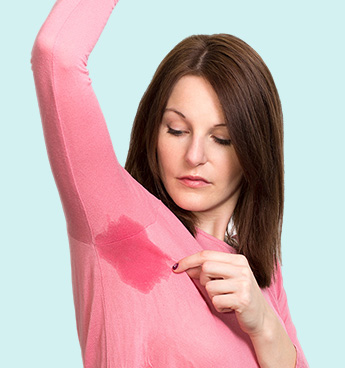
What is
Hyperhidrosis?
Hyperhidrosis is the medical term for excessing swearing. It occurs when overreactive sweat glands release a volume of sweat disproportionate to the volume required for your body’s cooling. Over 110,000 Australians suffer from excessive underarm swearing.

Types of
Hyperhidrosis
- Hyperhidrosis are usually classified into generalized hyperhidrosis or focal hyperhidrosis. There are subtypes of focal hyperhidrosis including axillary (underarms), palmar/plantar (palm and/or soles), craniofacial (face, crown on head) and inguinal (groin).
- Hyperhidrosis can be primary (no underlying disease or disorder) or secondary (occurring as a result of underling medical conditions, injury or certain mediations). The majority of cases are primary with different times of onset ranging from childhood to adulthood. Cases presenting later in life are more likely to be secondary.

Treatments
Treatment options differ for different types of hyperhidrosis. These will be discussed with you in the consultations for:
- Generalised hyperhidrosis
- Axillary hyperhidrosis (armpit swelling)
- Palmar hyperhidrosis
- Plantar hyperhidrosis
- Craniofacial hyperhidrosis
Living with hyperhidrosis
How hyperhidrosis can affect your life
Millions of people around the world suffer from hyperhidrosis. It can be an isolating chronic condition. Due to the embarrassing nature of the condition, more than half of the people are never diagnosed or treated for their symptoms. Severe primary axillary hyperhidrosis can affect people physically, psychologically and emotionally.
Some of the issues faced by people with hyperhidrosis are:
- Social embarrassment and difficulty going into public.
- Impact on ability and work performances.
- Difficulty meeting people and developing personal relationships.
- Needing to change clothes multiple times a day. Not being able to wearing certain types, colour and material of clothing.
- Increased time and energy to maintain personal hygiene
Which treatments are available for sever axillary Hyperhidrosis (underarm sweating)?
Antiperspirants
Most of the over-the-counter antiperspirants contain metallic salts. These salts work by reducing the amount of perspiration that reaches the skin by blocking the sweat ducts. Deodorants on the other hand help mask body odour, but are not designed to control sweating. Therefore Antiperspirants are often combined with deodorants to help reduce both odour and sweating.
Regular antiperspirants are usually insufficient for severe axillary hyperhidrosis. Clinical strength antiperspirants are more concentrated and can effectively relieve severe axillary hyperhidrosis. However, these often cause irritation especially if used incorrectly.
Botulium toxin injections
These work by temporarily blocking the nerve signals that stimulate the sweat glands. As a result, sweating is usually significantly reduced for a period of 4-12 months.
The procedure involves a short office visit. Each axilla (armpit) receives approximately 25 injections via a very fine needle. There is usually minor discomfort associated with the injection. Local anaesthetic cream (numbing cream) and ice can be further applied to reduce the discomfort. The procedure only takes around 10 minutes.
Previously, cost associated with botulium toxin injection had been one of the barriers to its use. However, PBS has now subsidized botulium toxin which has minimize the cost.
Am I eligible for an PBS subsidized injectable treatment?
People with severe primary axillary hyperhidrosis are eligible for treatment under the Pharmaceutical Benefits Scheme (PBS) if they are:
- Over age of 12,

- Intolerant of topical aluminium chloride hexahydrate (found in antiperspirants such as DricolorTM) after one or two months of treatment,
- Are treated by a PBS registered dermatologist or neurologist.
Surgery and other procedures
A variety of surgical approaches have been used to treat severe axially hyperhidrosis. Surgical options are usually reserved for the most extreme cases where other managements have failed. Surgical methods include removal of axillary sweat glands, endoscopic thoracic sympathectomy and other techniqiues. Our dermatologists can discuss with you further about these options if required.

